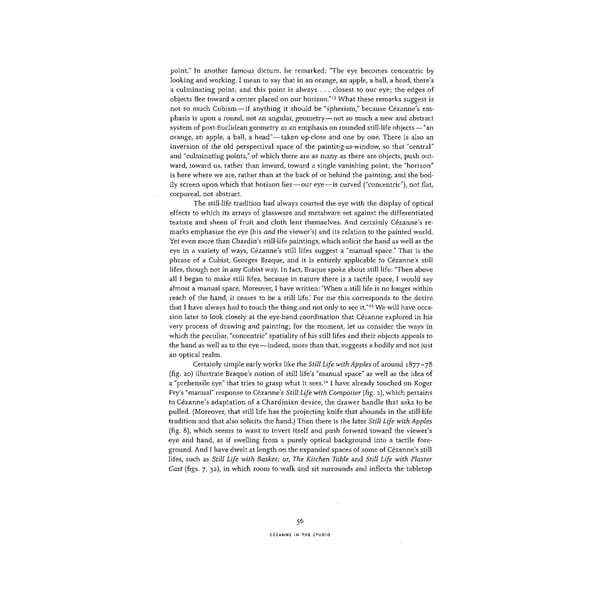point." In another famous dictum, he remarked: "The eye becomes concentric by looking and working. I mean to say that in an orange, an apple, a ball, a head, there's a culminating point; and this point is always . . . closest to our eye; the edges of 12 objects flee toward a center placed on our horizon." What these remarks suggest is not so much Cubism—if anything it should be "spherism," because Cezanne's em- phasis is upon a round/not an angular, geometry—not so much a new and abstract system of post-Euclidean geometry as an emphasis on rounded still-life objects—"an orange, an apple, a ball, a head"—taken up-close and one by one. There is also an inversion of the old perspectival space of the painting-as-window, so that "central" and "culminating points," of which there are as many as there are objects, push out- ward, toward us, rather than inward, toward a single vanishing point; the "horizon" is here where we are, rather than at the back of or behind the painting, and the bod- ily screen upon which that horizon lies—our eye—is curved ("concentric"), not flat, corporeal, not abstract. The still-life tradition had always courted the eye with the display of optical effects to which its arrays of glassware and metalware set against the differentiated texture and sheen of fruit and cloth lent themselves. And certainly Cezanne's re- marks emphasize the eye (his and the viewer's) and its relation to the painted world. Yet even more than Chardin's still-life paintings, which solicit the hand as well as the eye in a variety of ways, Cezanne's still lifes suggest a "manual space." That is the phrase of a Cubist, Georges Braque, and it is entirely applicable to Cezanne's still lifes, though not in any Cubist way. In fact, Braque spoke about still life: "Then above all I began to make still lifes, because in nature there is a tactile space, I would say almost a manual space. Moreover, I have written: 'When a still life is no longer within reach of the hand, it ceases to be a still life.' For me this corresponds to the desire 13 that I have always had to touch the thing and not only to see it." We will have occa- sion later to look closely at the eye-hand coordination that Cézanne explored in his very process of drawing and painting; for the moment, let us consider the ways in which the peculiar, "concentric" spatiality of his still lifes and their objects appeals to the hand as well as to the eye—indeed, more than that, suggests a bodily and not just an optical realm. Certainly simple early works like the Still Life with Apples of around 1877-78 (fig. 20) illustrate Braque's notion of still life's "manual space" as well as the idea of 14 a "prehensile eye" that tries to grasp what it sees. I have already touched on Roger Fry's "manual" response to Cezanne's Still Life with Compotier (fig. 2), which pertains to Cezanne's adaptation of a Chardinian device, the drawer handle that asks to be pulled. (Moreover, that still life has the projecting knife that abounds in the still-life tradition and that also solicits the hand.) Then there is the later Still Life with Apples (fig. 8), which seems to want to invert itself and push forward toward the viewer's eye and hand, as if swelling from a purely optical background into a tactile fore- ground. And I have dwelt at length on the expanded spaces of some of Cezanne's still lifes, such as Still Life with Basket; or, The Kitchen Table and Still Life with Plaster Cast (figs. 7, 32), in which room to walk and sit surrounds and inflects the tabletop 56 CÉZANNE IN THE STUDIO
 Cézanne in the Studio: Still Life in Watercolors Page 70 Page 72
Cézanne in the Studio: Still Life in Watercolors Page 70 Page 72